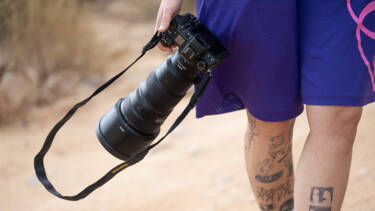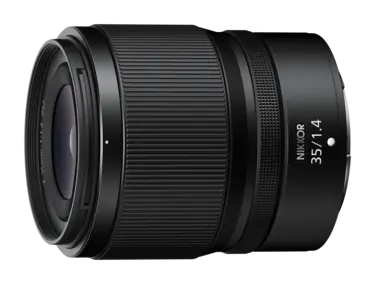The cinematic sweet spot of 35mm

Why is a 35mm focal length so beloved by filmmakers and how should you use it? Dom Salmon tells the story
Recently, I got my hands on the new NIKKOR Z 35mm f/1.4 and I really loved it for some video work I did. It just does so well at so many things. It’s always amazing given the huge range of options available, especially in modern camera tech, that some classic tropes still hold true (see my article on the 2.8 aperture in cinema here). And a 35mm lens for movies and video has a special place in my – and many people’s – heart, so what’s the story?
For videographers and movie makers, the 35mm lens holds a unique place as one of the most versatile and ‘cinematic’ options you can carry with you. It has curious mix of cool possibilities, straddling as it does the line between ultra-wide angles and standard or telephoto perspectives. This offers a creative option that is natural, yet also immersive, making it a real favourite for narrative storytelling, documentaries and even commercial work.
Combine that pleasing field of view with a fast aperture, such as f/1.4, and the 35mm lens transforms into a very powerful creative tool that allows videographers to achieve great subject separation and lush cinematic bokeh, establish planes of action in a frame and do it all with a low-light performance that reduces the need for complex lighting to get a decent exposure.
If I could only ever have one lens for my moving images, a fast 35mm is a no-brainer – and a lot of people would feel the same. So what are the key reasons why this lens remains a staple for every kind of movie-maker?
Balancing scope and intimacy
One of the greatest strengths of a 35mm lens is its ability to provide what I guess you’d call a balanced perspective, i.e. one that mimics human vision without noticeable distortion (which is much more apparent at 28mm, say). It sits very nicely between the ultra-wide, very dramatic 24mm and the tighter, more intimate 50mm, offering a natural field of view that doesn’t exaggerate depth or perspective but isn’t ‘in your face’ either.
Creating ‘context’
A 35mm lens allows you to capture enough of the environment to ‘place’ your subject in their surroundings without pushing it too far into the background. It’s a great way to immediately tell the viewer about a situation or a location without an ‘establishing shot’. Documentary interviews are hugely effective when you leverage this technique.
Adding character
Unlike wider focal lengths that introduce distortion or place too much emphasis on background elements, 35mm keeps the subject’s features pretty natural, while still maintaining a sense of depth to your frame. It’s a real antidote to that ultra-wide smartphone video look, where you think you’re vanishing up someone’s nose.
Moving movies
A 35mm lens helps cut down wobbly footage for handheld movement compared to a 50mm but isn’t as surreal-looking as a 24mm when you are tracking a subject. When twinned with your Nikon Z’s Vibration Reduction, you can get pretty rock-solid footage even handheld. But, crucially, it does have enough ‘drama’ and it looks great when you are moving through an environment, giving your audience a very immersive sense of space.
Enhanced storytelling
Wide angles are often associated with a very deep level of sharpness in your frame (just ask the makers of Citizen Kane). But with a super-fast aperture such as f/1.4, you can still get great separation of subject and background. That ‘context’ of the 35mm view helps lend a very cinematic and professional feel.
It’s a great way to pluck your subject out of the scene and make it prominent but still keep enough detail in the background to enhance the setting and mood. That’s very tricky in the very deep focus of a 24mm or the more isolating 50mm, which really demonstrates what constitutes the ‘sweet spot’ of a 35mm.
Because the night
It’s hard to overstate the logistic benefits of a fast 35mm when shooting. Yes, its bokeh, separation and field of view contribute to the emotion or story you want to tell. But, with a fast aperture, it also unlocks low-light video for you and therefore a ton of creative options. For nighttime, you can rely on real location lights such as streetlights or car headlights for your scene. For interiors, you can make everyday light sources such as computer screens or desk lamps your ‘motivated’ light. It’ll also speed up your workflow as you can be less reliant on movie lights to bump up your location’s brightness. It also gives your footage more a natural and realistic look when the viewer can ‘get’ where the light is coming from. From romantic, soft candlelight to gritty TV screens, you have many more creative options to illuminate your frame. Plus you won’t have to push your ISO as hard, so you’ll get cleaner, less noisy footage to work with.
A new chapter in your storytelling
As with most things that are a classic for a reason, the 35mm focal length helps you get into ‘movie mode’. It’s a great storytelling device, which is why it’s also a very popular length for street photography, because what’s a street photo if not a single frame from the bigger movie of life?
So, it’s good enough as is, but when that focal length is coupled with a super-fast aperture it’s simply untouchable as the single most usable movie lens you can get. It helps you create a host of great footage that isn’t vanilla, but also not overly stylistic, and that’s a huge boost for professional work. I could shoot everything on 24mm, dollying at floor level, but not every client wants scenes from The Shining!
Want proof of a 35mm’s cinematic power? Check out the movie Call Me by Your Name, which was shot entirely on one 35mm lens. The reason? The director wanted naturalism and a visual simplicity that allowed the story to breathe – plus a focal length that had enough of the human’s-eye view that the audience would feel they were an observer to the film. What one lens could do all that and really serve the story they wanted to tell? The 35, of course!
And, as ever, it’s the story that counts.
More by Dom Salmon
Discover the NIKKOR Z 35mm f/1.4

Unlock greater creativity








